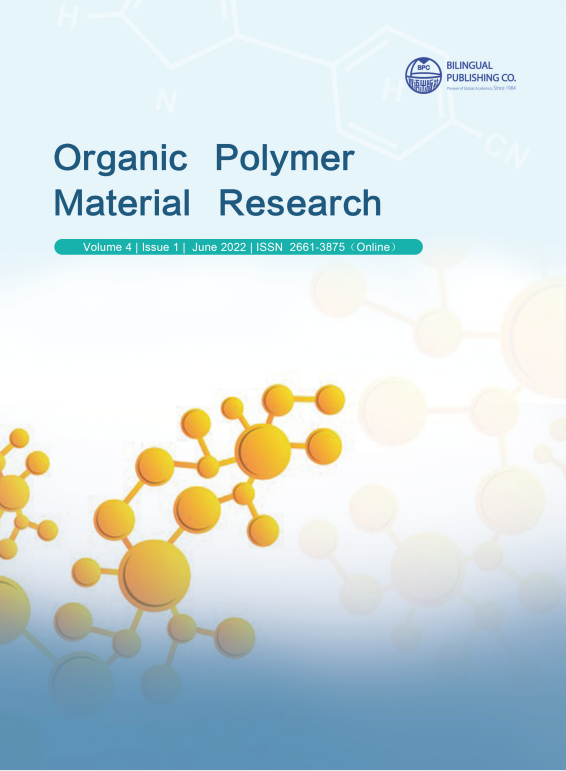-
240
-
156
-
149
-
133
-
118
ATR-FTIR Analysis on Aliphatic Hydrocarbon Bond (C-H) Formation and Carboxyl Content during the Ageing of DC Air Plasma Treated Cotton Cellulose and Its Impact on Hydrophilicity
DOI:
https://doi.org/10.30564/opmr.v4i1.4610Abstract
The surface of the cotton fabric was modified using a Direct current (DC) air plasma treatment and hence enhances its hydrophilicity. The Box-Behnken approach (design expert software) was used to optimise the input process parameters. The sample prepared under optimized condition is subjected to ATR-FTIR and Field Emission Scanning Electron Microscopy (FESEM) studies in order to determine the changes in hydrogen bond energies (EH), Total Crystallinity Index (TCI), Hydrogen Bond Intensity (HBI), Lateral Order Index (LOI), functionalization, lattice parameters (a, b, c & β), degree of crystallinity (in %) and surface etching. The ageing of this sample has been studied by comparing the values of carboxyl content and AC-C/AC-O-C ratio calculated using data extracted from ATR-FTIR spectra of the sample recorded periodically for one month.
Keywords:
Cotton cellulose; DC air plasma process; Ageing of sample; Aliphatic hydrocarbon bond (C-H) formation; Carboxyl contentReferences
[1] Prabhakaran, M., Carneiro, N., 2005. Effect of low temperature plasma on cotton fabric and its applications to bleaching and dyeing. Indian Journal of Fibre Textile Research. 30, 68-74.
[2] Lee, C.M., Kubicki, J.D., Fan, B., et al., 2015. Hydrogen-bonding network and OH stretch vibration of cellulose: comparison of computational modeling with polarized IR and SFG spectra. The Journal of Physical Chemistry B. 119(49), 15138-15149.
[3] Khai, D.M., Nhan, P.D., Hoanh, T.D., 2017. An investigation of the structural characteristics of modified cellulose from acacia pulp. Vietnam Journal of Science and Technology. 55(4), 452-460.
[4] O’Connor, R.T., DuPré, E.F., Mitcham, D., 1958. Applications of infrared absorption spectroscopy to investigations of cotton and modified cottons: Part I: Physical and crystalline modifications and oxidation. Textile Research Journal. 28(5), 382-392.
[5] Nelson, M.L., O’Connor, R.T., 1964. Relation of certain infrared bands to cellulose crystallinity and crystal lattice type. Part II. A new infrared ratio for estimation of crystallinity in celluloses I and II. Journal of Applied Polymer Science. 8(3), 1325-1341.
[6] Gaur, R., Semwal, S., Raj, T., et al., 2017. Intensification of steam explosion and structural intricacies impacting sugar recovery. Bioresource Technology. 241, 692-700.
[7] Poletto, M., Ornaghi, H.L., Zattera, A.J., 2014. Native cellulose: structure, characterization and thermal properties. Materials. 7(9), 6105-6119.
[8] El-Zawahry, M.M., Ibrahim, N.A., Eid, M.A., 2006. The Impact of Nitrogen Plasma Treatment upon the Physical-Chemical and Dyeing Properties of Wool Fabric. Polymer-Plastics Technology and Engineering. 45(10), 1123-1132. DOI: https://doi.org/10.1080/03602550600728943
[9] Malek, R.M., Holme, I., 2003. The effect of plasma treatment on some properties of cotton. Iranian Polymer Journal. 12, 271-280.
[10] Kalogianni, E.P., Savopoulos, T., Karapantsios, T.D., et al., 2004. A dynamic wicking technique for determining the effective pore radius of pregelatinized starch sheets. Colloids and Surfaces B: Biointerfaces. 35(3-4), 159-167.
[11] Pandiyaraj, K.N., Selvarajan, V., 2008. Non-thermal plasma treatment for hydrophilicity improvement of grey cotton fabrics. Journal of Materials Processing Technology. 199(1-3), 130-139.
[12] Struszczyk, H., 1986. Modification of lignins. III. Reaction of lignosulfonates with chlorophosphazenes. Journal of Macromolecular Science—Chemistry. 23(8), 973-992.
[13] Pimentel, G.C., Sederholm, C.H., 1956. Correlation of infrared stretching frequencies and hydrogen bond distances in crystals. The Journal of Chemical Physics. 24(4), 639-641.
[14] Nada, A.A.M., Kamel, S., El-Sakhawy, M., 2000. Thermal behaviour and infrared spectroscopy of cellulose carbamates. Polymer Degradation and Stability. 70(3), 347-355.
[15] TAPPI Standards: Regulations and Style Guidelines, 1977. https://www.tappi.org/globalassets/documents/standards/tm_guidelines_complete.pdf. Carboxyl Content of Pulp, T 237 os-77, 1-7.
[16] Anitha, S., Vaideki, K., Prabhu, S., et al., 2019. ATR-FTIR analysis on the hydrogen bonding network and glycosidic bond of DC air plasma processed cellulose. Journal of Molecular Structure. 1180, 378-391.
[17] Altaner, C.M., Horikawa, Y., Sugiyama, J., et al., 2014. Cellulose Iβ investigated by IR-spectroscopy at low temperatures. Cellulose. 21(5), 3171-3179.
[18] Nishiyama, Y., Langan, P., Chanzy, H., 2002. Crystal structure and hydrogen-bonding system in cellulose Iβ from synchrotron X-ray and neutron fiber diffraction. Journal of the American Chemical Society. 124(31), 9074-9082.
[19] McCord, M.G., Hwang, Y.J., Qiu, Y., et al., 2003. Surface analysis of cotton fabrics fluorinated in radio‐frequency plasma. Journal of Applied Polymer Science. 88(8), 2038-2047.
[20] Ward, T.L., Jung, H.Z., Hinojosa, O., et al., 1979. Characterization and use of radio frequency plasma‐activated natural polymers. Journal of Applied Polymer Science. 23(7), 1987-2003.
[21] Pandiyaraj, K.N., Selvarajan, V., 2008. Non-thermal plasma treatment for hydrophilicity improvement of grey cotton fabrics. Journal of Materials Processing Technology. 199(1-3), 130-139.
[22] Golova, O.G.P., Nosova, N.I., 1973. Degradation of cellulose by alkaline oxidation. Russian Chemical Reviews. 42(4), 327-333.
[23] Malek, R.M., Holme, I., 2003. The effect of plasma treatment on some properties of cotton. Iranian Polymer Journal. 12, 271-280.
[24] Kolářová, K., Vosmanská, V., Rimpelová, S., et al., 2013. Effect of plasma treatment on cellulose fiber. Cellulose. 20(2), 953-961.
[25] Kan, C.W., Yuen, C.W.M., 2006. Low Temperature Plasma Treatment for Wool Fabric. Textile Research Journal. 76, 309-314.
Downloads
How to Cite
Issue
Article Type
License
Copyright © 2022 Authors

This is an open access article under the Creative Commons Attribution-NonCommercial 4.0 International (CC BY-NC 4.0) License.




 S. Anitha
S. Anitha






